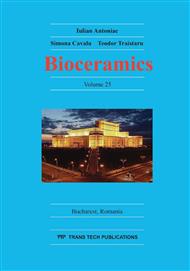p.121
p.128
p.132
p.141
p.147
p.154
p.160
p.165
p.171
Production and Mechanical Properties of Commercial Synthetic Hydroxyapatite (CSHA) Composites
Abstract:
Hydroxyapatite (HA), one of the calcium phosphate compounds, is the most widely used bioceramic. HA materials have a common usage in bone repairing due to its ability to accelerate the bone growth around the implant. HA is a biocompatible material and used in production of various kinds of prosthesis, repairing the cracked or broken bones and coating of metallic biomaterials. This study covers production and characterization of composite materials made of commercial synthetic hydroxyapatite (CSHA) with commercial inert glass, magnesium oxide and niobium (V) oxide additions (5 and 10 wt%), seperately. These additives used as reinforcement materials to improve the mechanical properties of CSHA based composites. The composites were subjected to sintering at different temperatures between 1000oC and 1300oC, then microstructures and mechanical properties of CSHA composites were investigated. The physical and mechanical properties were determined by measuring density, compression strength and Vickers microhardness (HV). Structural characterization was carried out with X-ray diffraction (XRD) and scanning electron microscopy (SEM) studies. In all composites, density values and mechanical properties increased with increasing sintering temperature. CSHA composite with 5 wt% CIG addition showed highest physical and mechanical properties among all CSHA composites produced in this study.
Info:
Periodical:
Pages:
147-153
Citation:
Online since:
November 2013
Authors:
Price:
Сopyright:
© 2014 Trans Tech Publications Ltd. All Rights Reserved
Share:
Citation:


